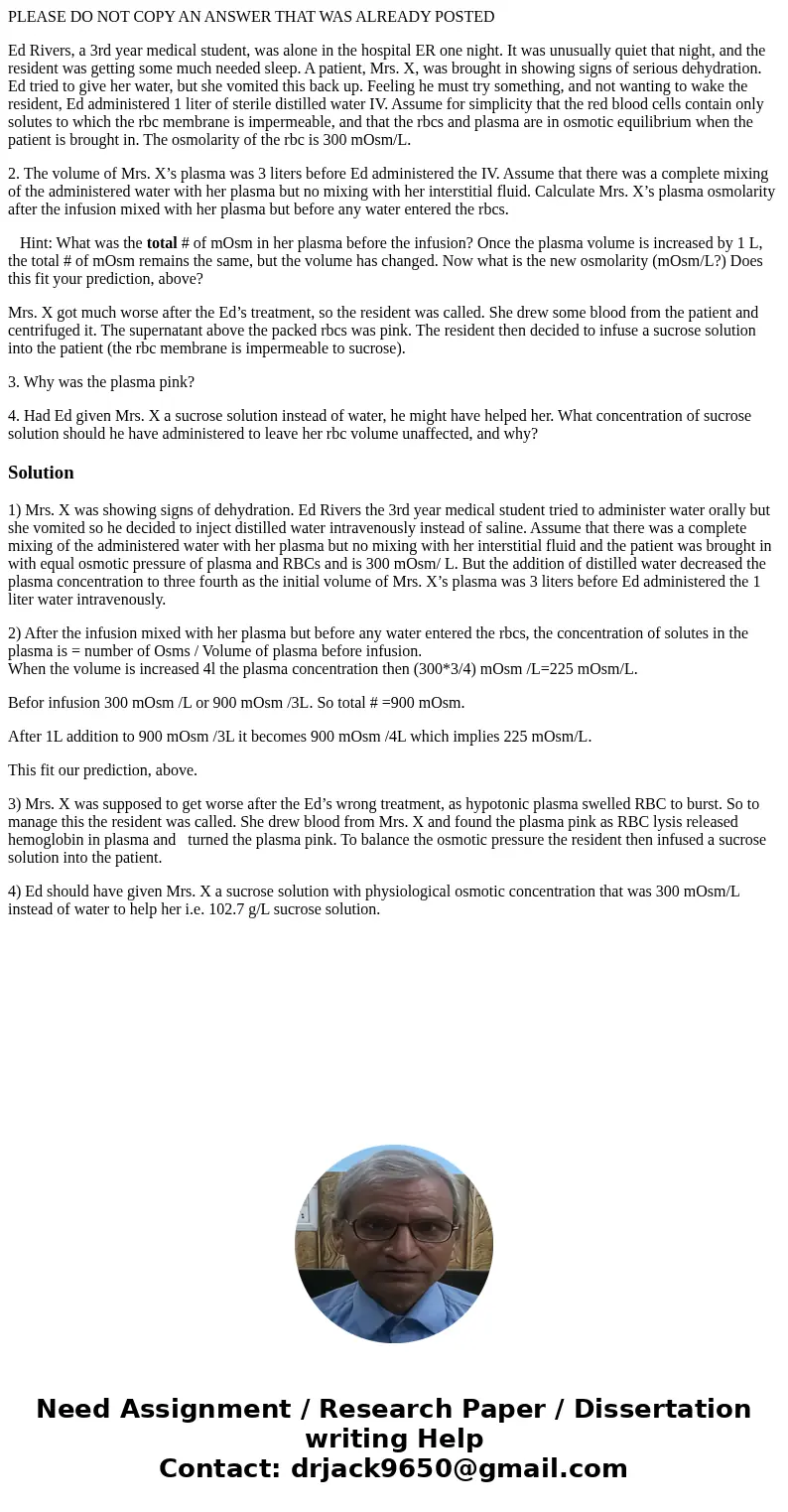PLEASE DO NOT COPY AN ANSWER THAT WAS ALREADY POSTED Ed Rive
PLEASE DO NOT COPY AN ANSWER THAT WAS ALREADY POSTED
Ed Rivers, a 3rd year medical student, was alone in the hospital ER one night. It was unusually quiet that night, and the resident was getting some much needed sleep. A patient, Mrs. X, was brought in showing signs of serious dehydration. Ed tried to give her water, but she vomited this back up. Feeling he must try something, and not wanting to wake the resident, Ed administered 1 liter of sterile distilled water IV. Assume for simplicity that the red blood cells contain only solutes to which the rbc membrane is impermeable, and that the rbcs and plasma are in osmotic equilibrium when the patient is brought in. The osmolarity of the rbc is 300 mOsm/L.
2. The volume of Mrs. X’s plasma was 3 liters before Ed administered the IV. Assume that there was a complete mixing of the administered water with her plasma but no mixing with her interstitial fluid. Calculate Mrs. X’s plasma osmolarity after the infusion mixed with her plasma but before any water entered the rbcs.
Hint: What was the total # of mOsm in her plasma before the infusion? Once the plasma volume is increased by 1 L, the total # of mOsm remains the same, but the volume has changed. Now what is the new osmolarity (mOsm/L?) Does this fit your prediction, above?
Mrs. X got much worse after the Ed’s treatment, so the resident was called. She drew some blood from the patient and centrifuged it. The supernatant above the packed rbcs was pink. The resident then decided to infuse a sucrose solution into the patient (the rbc membrane is impermeable to sucrose).
3. Why was the plasma pink?
4. Had Ed given Mrs. X a sucrose solution instead of water, he might have helped her. What concentration of sucrose solution should he have administered to leave her rbc volume unaffected, and why?
Solution
1) Mrs. X was showing signs of dehydration. Ed Rivers the 3rd year medical student tried to administer water orally but she vomited so he decided to inject distilled water intravenously instead of saline. Assume that there was a complete mixing of the administered water with her plasma but no mixing with her interstitial fluid and the patient was brought in with equal osmotic pressure of plasma and RBCs and is 300 mOsm/ L. But the addition of distilled water decreased the plasma concentration to three fourth as the initial volume of Mrs. X’s plasma was 3 liters before Ed administered the 1 liter water intravenously.
2) After the infusion mixed with her plasma but before any water entered the rbcs, the concentration of solutes in the plasma is = number of Osms / Volume of plasma before infusion.
When the volume is increased 4l the plasma concentration then (300*3/4) mOsm /L=225 mOsm/L.
Befor infusion 300 mOsm /L or 900 mOsm /3L. So total # =900 mOsm.
After 1L addition to 900 mOsm /3L it becomes 900 mOsm /4L which implies 225 mOsm/L.
This fit our prediction, above.
3) Mrs. X was supposed to get worse after the Ed’s wrong treatment, as hypotonic plasma swelled RBC to burst. So to manage this the resident was called. She drew blood from Mrs. X and found the plasma pink as RBC lysis released hemoglobin in plasma and turned the plasma pink. To balance the osmotic pressure the resident then infused a sucrose solution into the patient.
4) Ed should have given Mrs. X a sucrose solution with physiological osmotic concentration that was 300 mOsm/L instead of water to help her i.e. 102.7 g/L sucrose solution.

 Homework Sourse
Homework Sourse